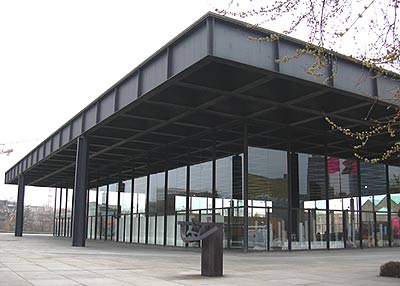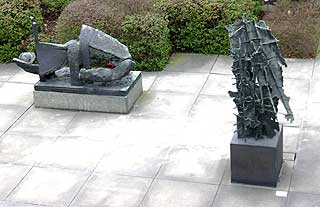












New National Gallery
![]() Address:
Address:
Neue Nationalgalerie
Potsdamer Straße 50
10785 Berlin-Tiergarten ![]() +49 (30) 266266247
+49 (30) 266266247![]() Transport Links:
Transport Links: ![]() S1, S2, S25, S26 Potsdamer Platz
S1, S2, S25, S26 Potsdamer Platz ![]() U2 Potsdamer Platz/Mendelssohn-Bartholdy-Park
U2 Potsdamer Platz/Mendelssohn-Bartholdy-Park ![]() 129, 148, 200, 348 Potsdamer Straße/Neue Nationalgalerie
129, 148, 200, 348 Potsdamer Straße/Neue Nationalgalerie ![]() Opening Times:
Opening Times:
Tues, Wed, Thurs, Fri 10am to 6pm
Sat, Sun, Christmas Day, Boxing Day 11am to 6pm
Thurs 10am to 10pm
The New National Gallery is the advanced work of the German architect Ludwig Mies van der Rohe (1886-1969). He was the last director of the Bauhaus. He became famous in Berlin as one of the most radical contemporary artists for his draft of the glass skyscraper in Berlin at the Friedrichstraße. In 1936, he immigrated to the USA to Chicago during the Nazi terror regime. Here, his first high rise buildings were created in the then groundbreaking skeleton building style. When the city of Berlin planed the Kulturforum with the Philharmonic of Hans Scharoun during the 1960ties, they were able to win Mies van der Rohe to build there a museum for modern art. A delicate, virtually floating glass-steel-construction was created. The house offers with an exhibition area of 4.900 square metres and around 800metre wall area a spaciousness, that is not obvious from the outside. The big glass hall of the upper floor and parts of the ground floor is used for special exhibitions. They attract annually 100.000 visitors.
![]() The permanent exhibition of the New Gallery
The permanent exhibition of the New Gallery
The permanent exhibition is situated at the ground floor of the building and houses European paintings and plastics from the 20th century from the classic contemporary to art of the sixties. Among them are works of artists like Kirchner, Picasso, Klee, Feininger, Dix and Kokoschka. The collection's main point forms the work of artists of cubism, expressionism, Bauhaus and surrealism. Works by Picasso, Gris, Leger and Laurens show the development of the cubism art. An additional overview of the cubism especially of the work of Picasso gives the collection Berggruen in Berlin-Charlottenburg. The expressionism is represented by the artist-society "Die Brücke" with important works by Kirchner, Schmidt-Rottluff and Heckel. Kirchner's "Potsdamer Platz" from 1914 stands today in exciting contrast to the current changes of the square, which is only a few metres away from the museum. At the background of the place describes Kirchner Berlin's nightlife after the start of the war. The main items of the collection are 11 paintings by Max Beckmann, who created those from 1906-1942. They give an overview of his work's development. The surrealistically painting is represented by artist like Ernst, Dali and Miro. Otto Dix and George Grosz document with their paintings the direction of verismo and the new objectivity. The school of Bauhaus is being depicted with works by their teacher Klee and Kandinsky. The collection's end point and the one of the highlights form the American painting of the 1960ties and 1970ties with abstract colour sections and rooms by Frank Stella and Ellsworth Kelly.

![]() To the Homepage of the New National Gallery
To the Homepage of the New National Gallery ![]() To the Homepage of the society Freunde der Nationalgalerie
To the Homepage of the society Freunde der Nationalgalerie![]() Sculptures are situated outside for people interested in object art. They are surrounding the building and also situated in the sculpture garden, which borders at the west. The garden can only be visited by arrangement. The visitor gets an overview of important plastics between figuration and abstraction in casual, relaxed surroundings.
Sculptures are situated outside for people interested in object art. They are surrounding the building and also situated in the sculpture garden, which borders at the west. The garden can only be visited by arrangement. The visitor gets an overview of important plastics between figuration and abstraction in casual, relaxed surroundings.